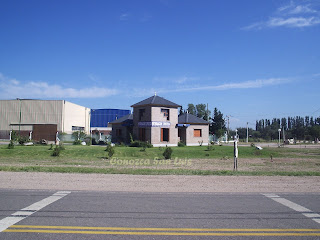
Quines , ubicada en el Dpto Ayacucho a 145 Km de la Ciudad capital sobre la Ruta Nacional 146, es una de las localidades más importantes del Norte provincial, por su población y por la importancia económica que data desde la época en que sus explotaciones de leña y carbón disminuyeron considerablemente el bosque nativo de la región.
Su nombre es de origen indígena y podría significar “Tierra caliente” Las primeras referencias históricas se remontan al año 1673 cuando esas tierras fueron otorgadas en merced al Capitán Domingo Sánchez Chaparro
Quines, located in the Department of Ayacucho 145 km from the capital city on National Route 146, is one of the most important Northern province, its people and the economic importance dating from the time that their holdings of firewood and coal declined considerably native forest in the region. His name is of indigenous origin and could mean "hot earth" The first historical references go back to the year 1673 when these lands were granted at the mercy Captain Domingo Sánchez Chaparro
En la actualidad un templo más moderno ocupa una de las calles principales del pueblo frente a la plaza principal.
Existe enorme veneración por la Virgen del Rosario, esta se ve reflejada año tras año, cuando miles de personas se encolumnan en procesión.
Las artesanías tienen un amplio desarrollo en la región.
At present a more modern temple occupies one of the main streets of the village off the main square. There is enormous reverence for the Virgin of the Rosary, this is reflected every year, when thousands of people were encolumnan in procession. Handicrafts have a comprehensive development in the region.
Trabajos en madera de algarrobo, tejidos en telar, curtidos y tallados en cuero, torneado de madera, son las principales actividades de muchos habitantes de Quines.
Jobs in wood carob, loom fabrics, leather and leather carving, wood turning, are the main activities of many inhabitants of Quines
Desde 1937 y por más de 50 años Quines contó con un ramal de ferrocarril proveniente de La Rioja, a donde salían los frutos del país, que se extraían de la zona.
Quines cuenta micro-clima subtropical, lo hace un área privilegiada para el turismo en general, además por su proximidad a las serranías. Con temperaturas óptimas en verano entre los meses de diciembre y enero que rondan máximas de 40° y los inviernos benignos en razón por su altitud sobre el nivel del mar.
Since 1937, and for more than 50 years Quines was a branch railway from La Rioja, where they left the fruits of the country, which were drawn from the area. Quines account micro-subtropical climate, what makes a privileged area for tourism in general, in addition to its proximity to the mountains. With summer temperatures best between the months of December and January to peak at around 40 ° and winters in benign reason for its altitude above sea level.
Parroquia San José
Frente a la plaza nueva, se encuentra la Igesia de San José, cuyo origen hay que encontrarlo en la petición de urbanizacón y ofrecimiento de tierras realizado al Gobernador Agustín Ortíz Estrada en 1871 por un grupo de vecinos, entre los cuales podemos citar a Justo Montiveros, Javier Alaniz y a Eduardo Leyes, quienes ofrecían tierras para la Iglesia, la plaza, calles y solares para los pobladores que deseen edificar.
Si bien se realizó el trazado de la nueva villa en el año 1873, se pidió al gobierno un subsidio en vista que la construcción del templo tardaba en iniciarse. A pesar de todo pasaron muchos años, hasta que en 1897 se comenzó la construcción del mismo, finalizandolo en 1904.La torre fue mandada a construir por el Pbro. Manuel Beltrán en 1908.
El Nuevo Templo se puso bajo la advocación de San José y la Iglesia perteneció a la Parroquia de Luján desde 1917 hasta 1976 año en que fue elevada al rango de Parroquia por Monseñor Rodolfo Laisse.
Faced with the new plaza is the Igesia San Jose, whose origin must be found in the request for urbanisation and land offer made to the Governor Agustin Ortiz Estrada in 1871 by a group of neighbors, among whom we quote Just Montiveros Javier Alaniz and Edward Law, who offered land for the church, the square, streets and areas for residents who wish to build. While it made the route of the new town in the year 1873, it asked the government for a grant given that the construction of the temple was slow to start. Despite all spent many years, until in 1897 began the construction of the same, finalizandolo in 1904. The tower was commissioned to be built by Fr. Manuel Beltran in 1908. The new temple was under the advocation of St. Joseph Church and belonged to the parish of Lujan from 1917 until 1976 when it was elevated to the rank of parish by Monsignor Rodolfo Laisse.








No hay comentarios.:
Publicar un comentario